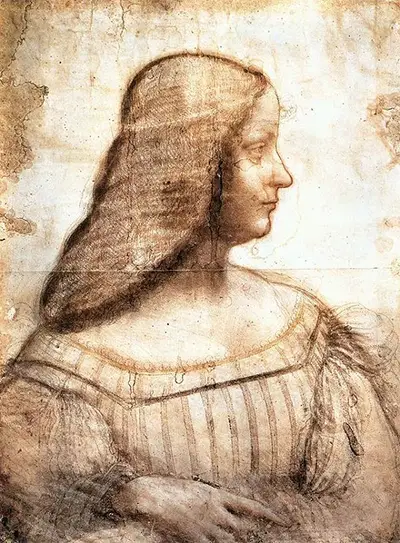Portrait of Isabella d'Este
Remarkable in proportions, and strikingly noble in the foreshortening of the bust; Portrait of Isabella d’Este majestically raises forth, outright outstanding for the perfectly linear profile and ambiguous choice of pose, with eyes gazing beyond our perceivable field of vision, but all in connexion with the turn of the body. The clear-cut profile witnessed in the distinguished sketching of the face, plus the grand use of space, in conjunction with the faintly slant turning of shoulders, in addition to the attention paid to the folded hands, all piece together in the clear embodiment of aristocracy. Isabella d’Este (1474 – 1539), Marchioness of Mantua, born into the Ferrara family, rulers of Ferra, was a renowned patron of Renaissance learning, in both art and literature. Besides her thirst for renaissance patronage, Isabella was a distinguished collector of art and antiquities, enthusiastically involved in the political intrigues among the twined nobles of Europe, as well as, a supporter of convents and monasteries, and is also credited with founding a girl’s school in Mantua. Isabella d’Este’s life and achievements are well-known throughout history in detail owing to the voluminous correspondence by her, as well as, others in her circle. This alleviating correspondence provides insight not only into the Renaissance world of art but also into the unique role she played, with more than two thousand of her letters still available today. In 1499, Leonardo da Vinci left Milan, when the French army stroke forth and invaded Italy. On his voyage to Venice, Leonardo da Vinci stopped at Mantua, where the renowned aristocrat Isabella d’Este asked of him to paint her portrait. Isabella was determined to have the best possible portrait of her gallant self: painted, struck on a coin, or sculptured. It was during this era that she made it her goal to surround herself with the most distinguished contemporary artist and among all, find the best possible portrait painter; one who could produce a picture-perfect, lifelike, seamless imitation of nature, and her choice fell on Leonardo da Vinci. It was when in Venice, that Leonardo da Vinci thus made this marvellous piece, and showed the portrait of Isabella d’Este to his friend Lorenzo da Pavia. Lorenzo is then said to have written a letter to the Marchesa on March 13, 1500, detailing that the distinguished Leonardo da Vinci is in Venice and that he had shown him the best possible portrait ever of her Ladyship. It was all too lifelike, very well done and that none else could ever be any better than this. But despite Isabella d’Este insistence, the painting was never done. This famous portrait of Isabella d’Este is still remains a sketch for the portrait that never was, and despite its fragile state in conservation, until today, the portrait of Isabella d’Este remains one of Leonardo’s finest head and shoulders portraits. It also is one of the only renowned drawings by the illustrious master that is highlighted with several colour pigments. Leonardo da Vinci (1452 – 1519), is one of the most famed artist in the history of Western Art. A founding father of the Renaissance revolution, admired for his virtuosity as an artistic and draughtsman in the meticulous handling of space, scrupulous depiction of light and shadow, as well as, an expert user of sfumato, an adept skill in art, in which colors and tones gradually shade into one, producing beautifully softened outlines. Throughout all of time and history, Leonardo’s sketchbooks and writings, offer us glimpses into the life of the ingenious polymath, for in Leonardo, painting is poetry seen rather than heard or felt.


